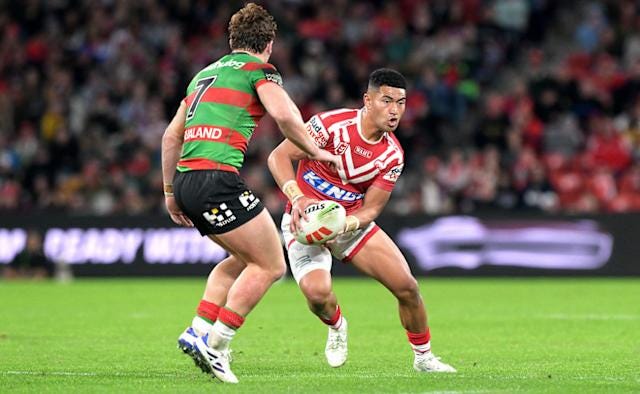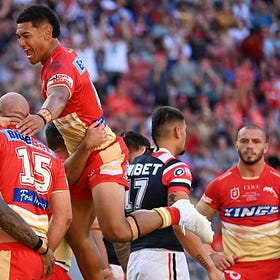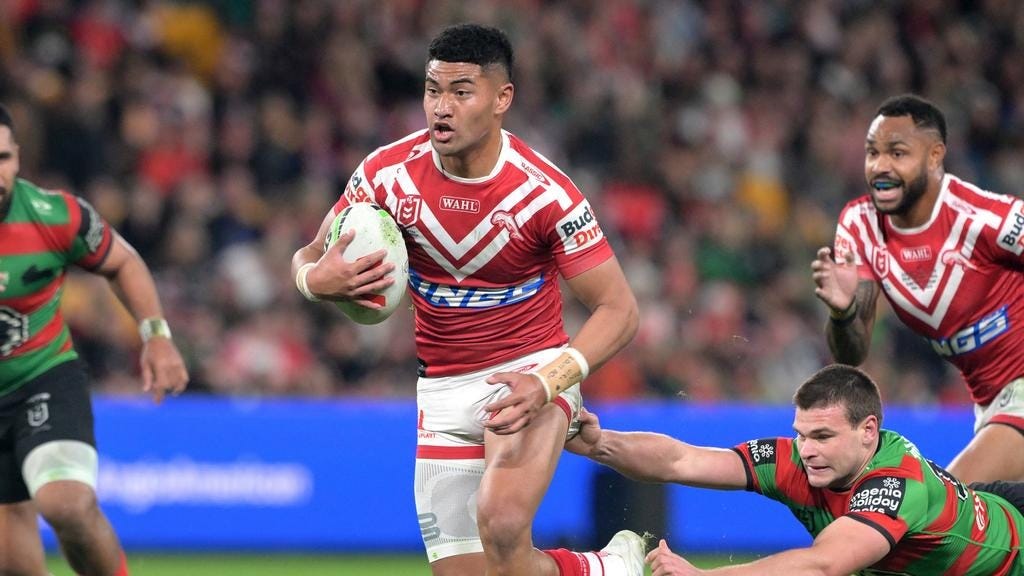Isaiya Katoa's AND1 Mixtape
Is the Dolphins prodigy the league's best ball handler?
For those of you loyal subscribers that have been along the journey since the very start, you nay remember (if you’re a sicko anyway) that one of my first newsletters was about the week to week growth between the first two games of Isaiya Katoa’s NRL career back in 2023.
Growing up in three minutes.
“There has to be protection or compensation. It’s a waste of time developing them. For us and other developing clubs, rival teams can just sit there and pluck them out.
Fast forward two years and all the public angst from Penrith at losing him has not only been justified (that debate ended a long time ago), but Katoa is entering that rare pantheon of massively hyped junior prospect that doesn’t completely wither away at the first sign of remote scrutiny.
Development isn’t linear, and for every success story like Katoa there’s dozens of cautionary tales that litter the road of bones between the Ched Towns Reserve and Kayo Stadium. Modern sports, not just rugby league, have become obsessed with chasing the next big thing instead of consolidating the proven quantity.
Not to get too into the Penrith developmental pathway weeds but there were real life people with the real life opinion as late as the beginning of 2024 that thought the Panthers made a mistake retaining Jarome Luai over Matt Burton after the 2021 season.
The mystery box is always better than the boat. The mystery box could even be a boat!
The growth of Katoa, to repeat my earlier line, hasn’t been linear. As with any 18 year old exposed to the rigours of a full NRL season a year after spending the majority of his time in Jersey Flegg (the Panthers demoted him from NSW Cup after he signed with the Dolphins), he faltered late in his rookie season.
His second season started similarly strong, before eventually finding himself dropped, the reasoning of which can be debated. Was it form related or Wayne Bennett spelling his young prodigy to protect superfluous miles on the legs early in his career.
This year though, the Glenmore Park product has gone to another level, spearheading one of the most vibrant attacking juggernauts in the league along with star fullback Hamiso Tabuai-Fidow, powering the Dolphins to the highest scoring points total in the league thus far (yes they’ve only had the one bye).
When I watch the Dolphins play, the eyes are naturally drawn to the sweeping, alluring attacks out wide with Tabuai-Fidow swooping on to a ball out the back and getting downhill, using the weapons in the outside backs like Herbie Farnworth and (the now-injured) Jack Bostock, but it all starts with the guile and craft of Katoa on the inside.
The great halfbacks play with several tones, the ability to control tempo has never been important in an era that is faster than ever, with in-rushing defensive lines and back rowers constantly hunting for playmakers’ ribs on the inside, spatial awareness and the ability to play slow-to-fast and fast-to-slow has become a premium trait, something that halves can go lifetimes without mastering, something Katoa appears to have a handle on far beyond his years.
I don’t want this to sound like I’m trying to justify jazz music to someone who only listens to drill rap, but the point of difference with Katoa isn’t an elite running game like a Mitchell Moses or Jahrome Hughes, he doesn’t kick teams to death like Nathan Cleary, and he doesn’t play off the cuff with the unpredictability of a leagues club salt shaker like a Cameron Munster.
His point of difference is…he does all those things.
Katoa might not be the best in any of those categories aforementioned but they all make up the various arrows in his bottomless quiver. The special part of Katoa’s game is that each of his unique traits help build off each other. We so often hear things about how a good running game can set up a passing game, and vice versa, and that may be true with Katoa, but it’s the unconventional nature and his ability to read and break tendencies that bely his years in the game.
“Ball handling” is a term I’ve struggled with in the past when it comes to American football with respect to evaluating quarterback play. Analysts will speak about ball handling in terms of how the quarterback sells play action fakes to collapse defensive boxes, how well they can sell one route before moving to a second read, and how they move defences with their arms, all before the ball is even cast in the air.
In that similar vein, Katoa may be the best pure “ball-handler” in the NRL already, although I am leading head first with this take having not run through the list in my head, but I truly don’t think there’s a better player at moving defenders with little intricate movements and pass fakes like the young Dolphin. If AND1 mixtapes were such a thing in the world of footy, the array of fakes, jinks and stutter steps purveyed by Katoa would fly off the shelves at any western Sydney or northern Brisbane Sanity branch.
If you go back and watch the game against the Rabbitohs from the weekend, where the Dolphins dropped yet another airstrike on an unsuspecting Taliban stronghold (I watched 12 Strong with Chris Hemsworth last night forgive me), and you’ll notice the deliberate way which Katoa engages the defensive line.
Playing sideways is often used to describe negative halfback play as it allows defences to slide and contain, with playing straight a trope often parroted by commentators when attacks struggle to break down a defensive line, and Souths hardly have the defensive fortitude of a marshy field in Champagne, France (I watched All Quiet on the Western Front on Saturday night, been on a real war movie binge lately, again, forgive me), but Katoa plays with a horizontal nature that feels like he’s sucking in a bad defensive decision and reacting to it.
He hides the ball when crabbing across the field, feigning dropping it off to an unders runner, before sparking a shift after one defender collapses when they shouldn’t (slow-to-fast). He attacks and digs into the line, before deliberately stopping, propping, and reading the next defender, hitting the short ball or playing out the back (fast-to-slow).
I’m not going to sit here and get too into technical detail about the intricacies of Katoa’s play because frankly that isn’t my forte and the best in the business, Jason Oliver from Rugby League Writers, has already broken down Katoa in far more detail than I ever could here.
All of this is to say, with the news that Katoa has been invited into the NSW Blues camp ahead of the decider as a train on player, his ascension is beginning to really smash through mainstream consciousness. It says a lot of the standing in which he’s considered by those in the upper echelon of the game that with both Jarome Luai and Nathan Cleary under various injury clouds (they’ve both since been passed fit to play), Katoa was almost the unanimous first drop selection should either be forced to miss.
With the volatility surrounding many halves situations around the league, the Dolphins have landed perfectly in the eye of the storm. As it turns out, raiding one of the best junior nurseries ahead of your inaugural season was a fruitful strategy. You wouldn’t fill out your brand new mansion with furniture off Facebook Marketplace would you.
Katoa will be reading out the Glenmore Park Brumbies in a pre-game video team list ahead of an interstate rumble soon enough should he wish to go down that avenue.
His play this year has made that almost a formality, a 10 year veteran trapped in the body of a teenager, and there’s no greater compliment.





Assuming Moses is injured next season... He'll play game 1 2026.
How could the panthers let him go!!!
Thanks tho.